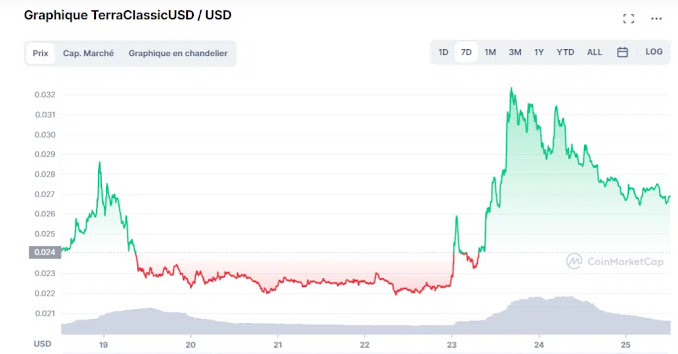USTC stablecoin rises 35% before falling back. The crypto market is an extremely volatile sector, so much so that it is most often difficult to anticipate even for the most experienced traders. This goes for the smallest movements as well as the most important ones.
Indeed, most investors never imagined that Terra, one of the major projects in the crypto ecosystem, would fall so precipitously. This event that took place last May brought the entire crypto market to its knees.
While the latter was already weakened by several months of a downtrend.
Similarly, Ethereum enjoyed a strong surge following July. And that for several weeks. So as to rise from 975.76 euros on July 1 to its recent high of 1965.77 euros on August 14. The fall of Terra or the recent craze for Ethereum came largely by surprise.
The latest move to confuse the market was the dramatic rally in the price of TerraClassicUSD (USTC), which enjoyed a 35% rise in a single day before heading back down.
READ MORE: Nike's NFT Revenue Surpasses $185 Million
Back in detail on the history of the Terra project
To fully understand why this 35% rally was a shock to the crypto market, you have to know that the TerraClassicUSD (USTC) is the exact same crypto that crashed last May. At the time, the latter was simply called TerraUSD (UST) and had fallen very sharply due to the loss of its peg to the US dollar.
TerraUSD was considered an algorithmic stablecoin capable of withstanding market variations. In addition to being associated with the crypto LUNA, it has maintained its price of almost 1 dollar until May 9. Thus, it benefited greatly from the confidence of investors.
Terra was founded in 2018 by Do Kwon, real name Kwon Do-Hyung, a Sur-Korean developer who first briefly worked for Microsoft before designing Terraform Labs. A project that raised nearly $150 million in funds and succeeded in attracting more than 2.5 million users. Do Kwon had a string of successes for several years until May 2022 when the Terra project collapsed in just under 8 days following the loss of its dollar stablecoin peg.
Note that Terra has been backed by crypto industry giants like Binance, OKX, Huobi, and Upbit, which also explains why investors have not hesitated to trust the project. Following the fall of TerraUSD and LUNA, the Terra blockchain project launched a new ecosystem called Terra 2.0. The old TerraUSD has been rebranded as TerraClassicUSD (USTC).
What explains this sudden rise of the USTC?
There is no notable event that explains this recent enthusiasm for the USTC stablecoin. As we discussed earlier, the Terra blockchain project to which the TerraUSD stablecoin and the LUNA token belonged renamed itself Terra 2.0. Thus, the future of TerraUSD, now TerraClassicUSD (USTC) is completely uncertain.
However, despite this, a number of investors believed that the stablecoin would regain its peg to the dollar, however, this seems highly unlikely.
Even though the USTC enjoyed a 35% increase in just under 24 hours between Tuesday, August 23 and Wednesday, August 24 according to CoinMarketCap. Going from 0.02235 euro to 0.03234 euro, it ended up going down to a price of 0.0269 euro on Thursday, August 25 around 11:35 a.m. (GMT+2).
In addition, many analysts as well as several reputable investors encourage the various crypto communities to stay as far away as possible from past and future projects related to the Terra blockchain. This is because of the risks of “ pump and dump ”.
As a reminder, this term designates a technique of market manipulation that consists in artificially raising the price of a share by false declarations, with the aim of reselling these shares, bought at a low price, with a high capital gain.
Betting on TerraClassicUSD at this time legitimately seems unreasonable, the implosion of the Terra ecosystem which was worth nearly $60 billion at its all-time high shook the entire crypto landscape. Thus, it is necessary to act with great caution if you wish to manipulate this type of financial asset.





0 Comments